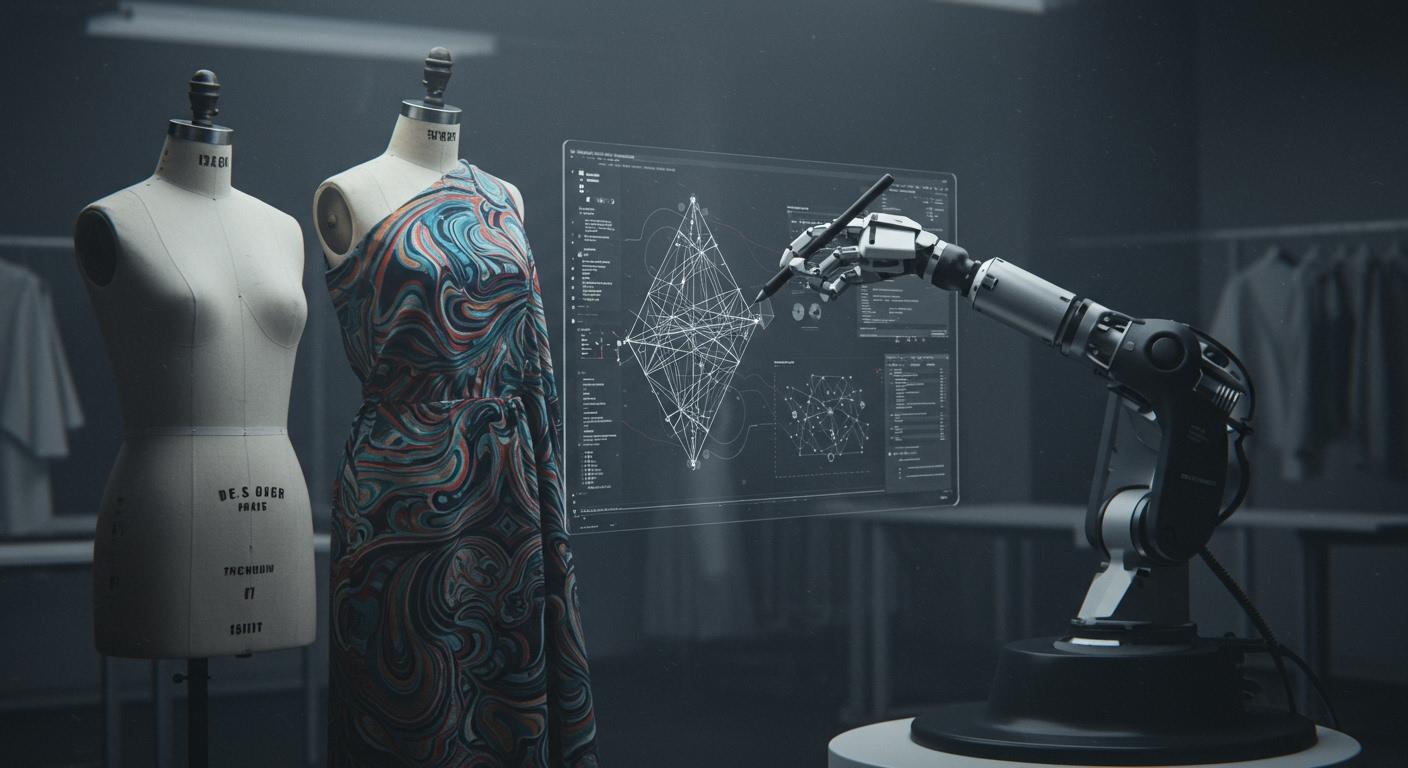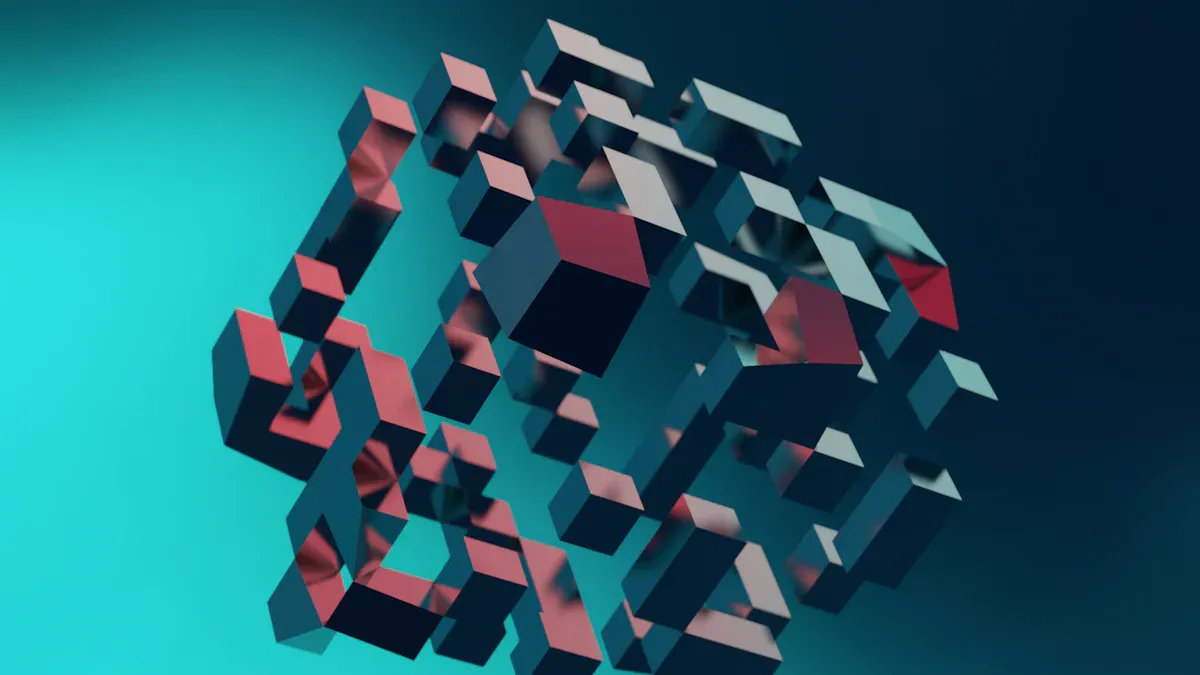
Generative AI is transforming the fashion industry. This technology creates unique patterns from simple text or image inputs. The generative AI learns from huge visual datasets. It produces new designs and boosts creativity. This process helps brands quickly develop new fashion collections. The impact of generative AI in fashion is growing rapidly. Many executives see AI as a top priority.
- 73% of fashion executives prioritize the use of generative AI.
- 62% report their companies have already used this AI technology.
This widespread adoption shows the powerful role generative AI now plays in creating patterns and shaping the future of fashion.
How Generative AI Creates Patterns

Generative AI transforms a simple idea into a complex visual. The process begins with a human touch and ends with a machine-generated design. This collaboration is reshaping creative designing in the fashion industry.
From Creative Prompt to Pattern
A designer starts with a creative concept. They translate this idea into a detailed text prompt for the generative AI. The AI then analyzes the prompt. It breaks down the words into elements like colors, shapes, and textures. The AI understands art as patterns it can analyze and recreate. For example, a designer might use a prompt for a specific style.
The generative AI uses its training on vast datasets to generate a visual that matches the description. This is a core function of generative AI in fashion.
AI-Powered Generation and Iteration
The first generative output is rarely the final one. Designers engage in an iterative cycle to perfect the design. This process involves structured experimentation.
- Generate: The designer provides the initial prompt to the AI.
- Review: They evaluate the AI's output for accuracy and quality.
- Refine: The designer adjusts the prompt, adding constraints or clarifying details.
- Repeat: They repeat this cycle until the AI produces the desired result.
This feedback loop treats the AI as a creative collaborator. It allows for continuous improvement, moving beyond guesswork to achieve a specific vision for fashion patterns.
Integration into Design Workflows
Modern AI technologies integrate directly into existing fashion design software. For instance, Marvelous Designer 2024.1 now includes generative AI tools. Designers can create clothing patterns from text prompts inside the application. Other platforms, like Catalyst AI by Six Atomic, analyze a brand's past designs. This ensures new generative creations align with the brand's identity. These integrations connect the AI to Product Lifecycle Management (PLM) systems. This streamlines the entire workflow from initial concept to final production, making the use of generative AI in fashion highly efficient.
Using Generative AI for Business Growth
Generative AI for business offers more than just creative tools. It provides a clear competitive advantage in the fast-paced fashion market. Brands use this technology to grow their operations, respond to market changes, and improve financial performance. The use of generative AI for business is reshaping how fashion companies approach growth and innovation.
Accelerating Trend Responsiveness
The fashion industry moves at lightning speed. New trends emerge and disappear quickly. Generative AI gives brands the ability to react instantly to these changes. This technology is crucial for predicting trends and accelerating design cycles. The use of generative AI for business helps companies stay ahead.
Fast fashion giants like Zara already use generative AI in their design process.
- Trend Forecasting: AI systems analyze social media data and on-site engagement. This analysis predicts popular styles, allowing the launch of new designs in just a few days.
- Automated Supply Chain: AI manages a network of suppliers and automates order routing. This process significantly speeds up production lead times.
- Rapid Prototyping: Designers input parameters like "minimalist summer dress" into an AI. The AI generates multiple design options that align with current consumer preferences. This cuts down conceptualization time.
This rapid response capability transforms the entire production timeline. Generative AI for business makes the process much faster.
Generative AI significantly reduces the time from concept to product launch. What used to take months of back-and-forth between teams now happens in days or even hours. This acceleration is achieved through AI tools that create virtual models for prototyping.
This speed allows brands to capitalize on micro-trends. They can launch relevant new collections weeks before a trend becomes mainstream. This responsiveness is a powerful driver of growth in the modern fashion market.
Achieving Mass Uniqueness
Today's consumers want products that feel unique. Generative AI for business helps brands meet this demand through "mass uniqueness." This concept involves using AI to create endless pattern variations at scale. It allows companies to offer differentiated products without the high cost of manual design. This approach to personalized fashion is changing the industry.
AI tools can generate unique patterns from various data sources. For example, AI-generated microbiome prints use biological data to create one-of-a-kind designs. No two microbiomes are identical, so each generative pattern is completely unique. This level of personalization helps brands create limited-edition collections that tell a compelling story. The AI algorithm interprets complex data to influence shape, color, and texture.
This technology offers designers powerful capabilities:
- Convert hand-drawn sketches into weave-ready patterns.
- Explore dozens of generative pattern variations instantly.
- Modify existing weaves with intuitive visual tools.
This process moves fashion beyond mass production. It enables mass customization and personalized shopping experiences. Brands can offer truly personalized items, strengthening customer loyalty and differentiating themselves in a crowded market. The use of generative AI in fashion makes this possible.
Reducing Design Costs
Developing new collections traditionally involves high costs. Physical sampling and textile waste are major expenses. Generative AI directly addresses these issues. It streamlines the design phase and reduces material consumption. This makes generative AI for business a financially smart choice.
Virtual prototyping is a key cost-saving feature of generative AI. Designers can create and test thousands of digital samples without using any physical fabric. This digital process provides significant savings.
- AI-powered virtual prototyping can decrease physical sample production by up to 40%.
- This leads to overall prototyping cost savings between 40% and 60%.
This efficiency also promotes sustainability. By minimizing physical prototypes, brands reduce textile waste. AI optimization can slash fabric waste by up to 20%. Some advanced systems even reduce waste by up to 90% by creating custom-fit garments. This reduction in waste not only lowers costs but also aligns with growing consumer demand for sustainable fashion. The use of generative AI in fashion helps companies become more efficient and responsible.
Essential AI Tools and Tech

Choosing the right tools is crucial for leveraging generative AI for business success. A wide range of platforms exists. Some offer broad creative freedom, while others provide specialized solutions for the fashion industry. Understanding these options helps brands select the best AI technologies for their specific needs.
Leading Pattern Generation Platforms
Designers have access to both general-purpose and industry-specific AI tools. General platforms are great for initial concepts, while specialized software streamlines the path to production.
General-purpose text-to-image generators like Midjourney and DALL-E 3 are popular starting points.
- Midjourney excels at creating high-quality, conceptual visuals from imaginative prompts. It is ideal for mood boards and fashion illustrations. Its Omni-Reference feature allows designers to include a specific motif or logo in new images. This helps visualize a generative print on a styled model, speeding up prototyping. However, it lacks tools for creating production-ready repeating patterns.
- DALL-E 3 shows strong performance in replicating color schemes and body prints from detailed descriptions. Studies show it can struggle with specific technical details. For example, it might generate a dress with the wrong neckline or use polyester buttons instead of specified snap buttons.
While these tools are excellent for ideation, specialized platforms offer more direct value for generative AI for business. These AI technologies are built for the fashion workflow.
"Style3D AI revolutionizes clothing pattern making by merging AI-driven pattern drafting with realistic 3D visualization and virtual try-ons. Our platform empowers designers to create production-ready garments efficiently while fine-tuning fit and fabric effects digitally. This holistic solution reduces reliance on physical samples and speeds up go-to-market timelines, making Style3D AI the essential partner for modern fashion innovation."
Many platforms now offer end-to-end solutions. Systems like AIpparel and Design2GarmentCode generate precise, simulation-ready sewing patterns from a simple prompt. They can create a full technical package with multi-angle views, material suggestions, and 3D models. The table below compares several leading tools.
| Tool Name | Use Case | Output Type | Key Features | Suitability |
|---|---|---|---|---|
| Catalyst AI | Production-ready patterns | DXF, PDF | Brand-consistent, custom sizing | Fashion brands, professionals |
| Style3D AI | Integrated pattern creation & 3D simulation | Production-ready 3D models | AI-powered pattern creation, 3D garment simulation | Independent designers, large fashion houses |
| Canva (PatternedAI) | Seamless fabric patterns | Repeatable designs | Text/image prompt based | Textile designers |
| Pietra AI | Fabric pattern changer | Edited fabric images | Virtual pattern swaps | Marketing, fashion designers |
These advanced AI tools help designers move from a creative idea to a manufacturable product with greater speed and accuracy. This makes generative AI for business a practical reality.
Training Custom AI Models
Off-the-shelf AI tools are powerful, but brands with a distinct identity often need more. Training a custom generative AI model on a company's own design archive is the solution. This process ensures that new generative patterns align perfectly with a brand's unique aesthetic. It is a key strategy for using generative AI for business.
The process of training a custom AI model involves several key steps:
- Collect and Prepare Data: A brand gathers its design archive, including images of past patterns, sketches, and garments. This data must be cleaned and organized for the AI.
- Choose the Right Architecture: The team selects a generative AI model, such as a Generative Adversarial Network (GAN), which is excellent for image generation.
- Train the Model: The prepared dataset is fed into the AI. The model learns the brand's specific patterns, color palettes, and stylistic elements.
- Test and Validate: The trained AI generates new designs. The team evaluates these outputs for accuracy, consistency, and alignment with the brand identity.
- Deploy the Model: The validated model is integrated into the design workflow.
- Continuous Improvement: The AI is periodically retrained with new data to keep it updated with the brand's evolving style.
- Norma Kamali trained an AI on 57 years of her archives. The AI generates new sketches that refresh her iconic styles.
- Collina Strada fed its design history into an AI system for its Spring 2024 collection. The AI produced novel concepts that the design team then refined.
- Moncler uses custom generative AI to innovate its quilted textures and create AI-generated marketing campaigns.
- Tommy Hilfiger allowed customers to co-design garments using a prompt-based AI during Metaverse Fashion Week, boosting engagement.
Building a proprietary AI model is a significant investment. Costs for smaller projects can start around $50,000, while extensive enterprise solutions can reach millions. The investment covers infrastructure, data acquisition, and the salaries of AI experts. For brands committed to innovation, a custom AI is a powerful asset for long-term growth and a core part of their generative AI for business strategy. These AI technologies help them protect their unique identity while scaling creativity.
Challenges and Future Outlook
The rapid rise of generative AI for business creates complex legal questions and reshapes future job roles. Brands must navigate these challenges to unlock the full potential of this technology. Success in the evolving fashion market depends on addressing these issues proactively. This forward-thinking approach is vital for any generative ai for business strategy.
Navigating Copyright and Originality
Copyright ownership for AI-generated patterns is a legal gray area. Current laws protect original works from a human mind. This creates a problem for designs made by an AI. The U.S. Copyright Office states that AI-assisted work can be protected, but only with significant human authorship. Courts are still deciding who owns AI creations. This uncertainty affects the fashion market.
Brands using generative AI for business face ethical questions too. Many AI models train on images from the internet without the original artist's permission. To navigate these issues, companies should:
- Develop Clear AI Policies: Create internal rules for using AI that focus on intellectual property and ethics.
- Ensure Human Oversight: Keep designers involved to add originality and ensure compliance with copyright law.
- Use Licensed Data: Train custom AI models using licensed data or images from the public domain to avoid infringement.
- Consult Legal Experts: Work with lawyers who specialize in AI to understand the risks.
The Future of Generative AI in Fashion
The future of generative AI in fashion looks transformative. Experts predict AI will evolve from a simple tool into an autonomous system that guides creative decisions. The generative ai market is set for huge growth. Projections suggest generative AI could add between $150 billion and $275 billion to the fashion industry's profits within five years. This shows the massive financial impact of generative ai for business.
This technology will not replace human designers. Instead, it will change their roles and elevate the appreciation for physical craftsmanship in fashion.
The future will likely see more "beautiful blended technicians." These professionals will combine traditional design skills with AI expertise. Human insight will remain crucial for interpreting AI-generated trends and guiding the creative vision. This blend of human and machine will define the next era of the fashion market.
Generative AI is a transformative force in fashion. It is not just a novelty. This technology offers brands major benefits. It provides speed, variety, and efficiency for pattern creation. The use of generative AI in fashion empowers brands to be more agile. The AI enhances human creativity, it does not replace it.
The future of fashion will see a deeper partnership between human designers and generative AI. This collaboration will reshape the design landscape.
- AI will generate custom prints for individuals.
- On-demand 3D-printed clothing will lead to zero waste.
This powerful AI tool is making fashion smarter and faster.
FAQ
Will AI replace fashion designers?
No, AI will not replace human designers. It acts as a powerful creative partner. Designers use AI to explore ideas and accelerate their workflow. Human skill remains essential for guiding the AI, refining designs, and understanding physical clothing construction.
What is the main benefit of using AI for fashion patterns?
The primary benefit is speed. 🚀 Generative AI produces countless unique pattern options in hours instead of weeks. This speed allows brands to react instantly to new market trends and launch collections much faster than before.
Is it expensive for brands to use AI?
The cost varies. Subscription-based tools are affordable for basic ideation. Building a custom AI model requires a larger investment. However, AI reduces long-term expenses by cutting down on physical samples and minimizing textile waste during the design phase.
Who owns the copyright for AI-generated patterns?
Copyright for AI creations is a complex legal area.
A design usually needs significant human authorship to qualify for copyright protection. Brands must ensure their designers actively guide and modify AI outputs to claim originality and ownership over the final pattern.
See Also
AI's Role in Managing Viral Trends Within the Fast Fashion Industry
Machine Learning: Predicting Fashion Trends to Significantly Boost Retail Sales
Innovative Fashion AI Solutions for a More Sustainable and Better Planet
Implementing Smarter Fashion AI for Immediate Streamlined Return Processes
Dynamic Safety Stock AI: The Premier 2025 Fashion Retail Solution